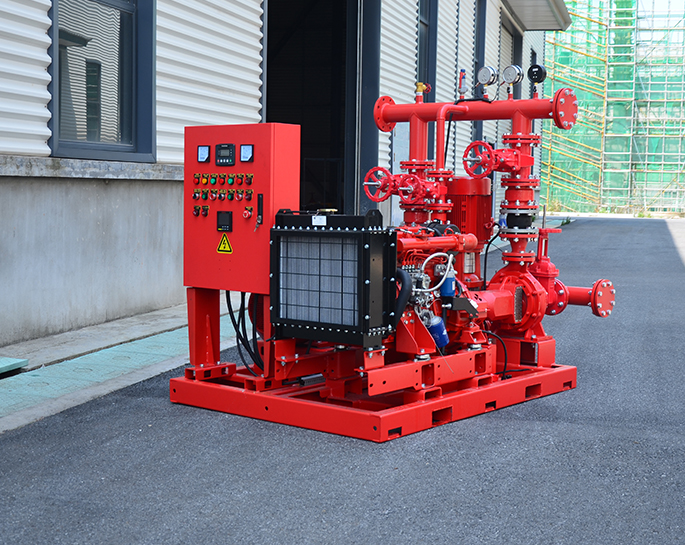How do firefighting pumps contribute to water conservation efforts?
Apr 25, 2024
Share:
Firefighting pumps contribute to water conservation efforts in several ways:
1. **Efficient Water Application**: Modern firefighting pumps are equipped with advanced nozzles and delivery systems that allow firefighters to apply water more efficiently. By delivering water in a controlled manner with adjustable flow rates, firefighters can target the fire directly, minimizing water wastage.
2. **Variable Flow Rates**: Many firefighting pumps feature variable speed or flow rate control, allowing firefighters to adjust the amount of water being discharged according to the size and intensity of the fire. This flexibility helps conserve water by avoiding excessive use in situations where lower flow rates are sufficient.
3. **Recirculation Systems**: Some firefighting pumps incorporate recirculation systems that allow water to be reused during firefighting operations. Instead of continuously drawing water from external sources, these systems recirculate water already within the firefighting apparatus, reducing the need for additional water supply and conserving resources.
4. **Foam and Water Mist Systems**: Firefighting pumps often support the operation of foam and water mist systems, which can be more effective than traditional water-only methods in certain scenarios. By using foam or mist additives, firefighters can achieve quicker fire suppression with less water, thus conserving resources while maintaining firefighting effectiveness.
5. **Dual-Agent Systems**: Dual-agent firefighting systems combine water with other extinguishing agents, such as foam or dry chemicals, to enhance firefighting capabilities while minimizing water usage. These systems are particularly useful for combating specific types of fires, such as flammable liquid fires, where water alone may be less effective.
6. **Monitoring and Control Systems**: Advanced monitoring and control systems integrated into firefighting pumps provide real-time feedback on water usage, pressure levels, and system performance. By monitoring these parameters, firefighters can optimize their firefighting tactics to maximize water conservation without compromising safety or effectiveness.
7. **Training and Education**: Firefighters are trained to use water resources judiciously and efficiently during firefighting operations. Training programs emphasize the importance of water conservation principles and techniques, such as proper nozzle selection, effective stream application, and tactical water management strategies.
Overall, firefighting pumps play a crucial role in water conservation efforts by enabling firefighters to use water resources more efficiently and effectively while mitigating the impact of fires on the environment. Through the adoption of advanced pump technologies and firefighting practices, water usage during firefighting operations can be minimized without sacrificing fire suppression capabilities.

1. **Efficient Water Application**: Modern firefighting pumps are equipped with advanced nozzles and delivery systems that allow firefighters to apply water more efficiently. By delivering water in a controlled manner with adjustable flow rates, firefighters can target the fire directly, minimizing water wastage.
2. **Variable Flow Rates**: Many firefighting pumps feature variable speed or flow rate control, allowing firefighters to adjust the amount of water being discharged according to the size and intensity of the fire. This flexibility helps conserve water by avoiding excessive use in situations where lower flow rates are sufficient.
3. **Recirculation Systems**: Some firefighting pumps incorporate recirculation systems that allow water to be reused during firefighting operations. Instead of continuously drawing water from external sources, these systems recirculate water already within the firefighting apparatus, reducing the need for additional water supply and conserving resources.
4. **Foam and Water Mist Systems**: Firefighting pumps often support the operation of foam and water mist systems, which can be more effective than traditional water-only methods in certain scenarios. By using foam or mist additives, firefighters can achieve quicker fire suppression with less water, thus conserving resources while maintaining firefighting effectiveness.
5. **Dual-Agent Systems**: Dual-agent firefighting systems combine water with other extinguishing agents, such as foam or dry chemicals, to enhance firefighting capabilities while minimizing water usage. These systems are particularly useful for combating specific types of fires, such as flammable liquid fires, where water alone may be less effective.
6. **Monitoring and Control Systems**: Advanced monitoring and control systems integrated into firefighting pumps provide real-time feedback on water usage, pressure levels, and system performance. By monitoring these parameters, firefighters can optimize their firefighting tactics to maximize water conservation without compromising safety or effectiveness.
7. **Training and Education**: Firefighters are trained to use water resources judiciously and efficiently during firefighting operations. Training programs emphasize the importance of water conservation principles and techniques, such as proper nozzle selection, effective stream application, and tactical water management strategies.
Overall, firefighting pumps play a crucial role in water conservation efforts by enabling firefighters to use water resources more efficiently and effectively while mitigating the impact of fires on the environment. Through the adoption of advanced pump technologies and firefighting practices, water usage during firefighting operations can be minimized without sacrificing fire suppression capabilities.


.png)
.png)

.png)


